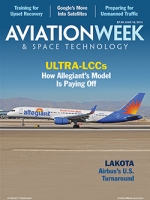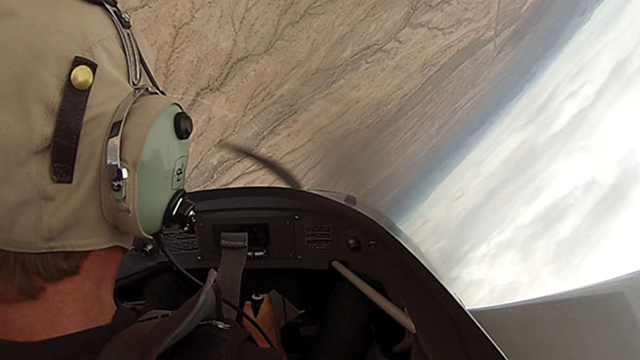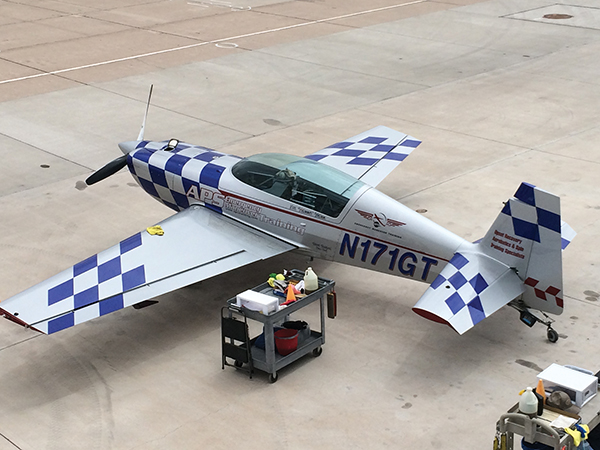
Review the Original Article at Aviation Week: Reconsidering Upset Recovery Training
Important Note to Readers: Below, APS comments on some elements of this article. These comments are NOT part of the original article but serve to clarify concepts mentioned in the coverage in the interest of preserving the safe and effective delivery of Upset Prevention & Recovery Training (UPRT) solutions.
Reconsidering Upset Recovery Training
The best textbooks and simulators may not adequately prepare a pilot for the gut reaction of suddenly becoming inverted after an upset like a wake vortex encounter, and neither does traditional pilot training. Guidance on the topic—unload the wing and roll to the nearest horizon—makes sense on paper or visually, but cannot account for or predict the psycho-physiological response in the moment of crisis, what scientists call the pilot’s naturalistic decision-making process.

Face-to-face with this type of extreme unusual attitude for the first time, an untrained pilot is likely to either pull back on the control column in a “split-S” high-G dive toward the ground or do nothing, both of which could lead to an unrecoverable loss of control in-flight (LOCI) within 5 sec., says Karl Schlimm, director of flight operations at Aviation Performance Solutions (APS). Schlimm gave Aviation Week a greatly compressed version of APS’s upset prevention and recovery training (UPRT) course in an Extra 300L at the company’s Mesa, Ariz., headquarters on April 11. APS is one of 137 companies offering UPRT in the U.S., according to the International Aerobatic Club (IAC), but it is the largest UPRT provider in the world, training approximately 1,000 pilots per year, mostly for business aviation clients. Airline clients are a emerging part of that business, with the company set to provide UPRT to instructors from South African Airways in August. [SEE COMMENT 1 BELOW]
South African Airways (SAA) is the first of an increasing number of airlines that are evaluating APS and its closest competitor, Mojave, Calif.-based Flight Research, for help with meeting new global mandates to provide pilots with UPRT. At present, the two companies form a duopoly for in-aircraft UPRT training for the airline sector, although more competitors are likely to begin offering the services if demand grows.
Largely as the result of the Colgan AirBombardier Q400 crash near Buffalo, N.Y., in 2009, the FAA in November 2013 finalized a new pilot training rule that will require airlines to provide pilots with “extended envelope” training in simulators by November 2018. The full-motion simulator-based training is to include upset recovery maneuvers as well as recovery from full stalls and stick pusher activations, among other abnormal events. Aviation authorities elsewhere are following suit.

Debate is ongoing as to whether simulators can adequately address the training needs as opposed to in-aircraft training, and among in-aircraft training advocates, debate continues over what equipment is more representative of swept-wing airliners. “The whole market is trying to decide what side of the fence they’re on,” says Mark Leeper, director of business development for Flight Research, of the in-aircraft versus in-simulator training question. Flight Research uses a fleet of 10 North American Sabreliner business jets and Aermacchi MB-326 Impala jet trainers for its upset recovery training courses. [SEE COMMENT 2 BELOW]
Leeper says his company is seeing “extensive interest” from airlines, which in many cases want to train their pilots in aircraft “that resemble the aircraft they fly operationally,” a criticism of APS’s use of single-engine, piston-powered aircraft for its training. “If you want to teach someone to play football, you don’t hand them a baseball,” he says. [SEE COMMENT 3 BELOW]
Paul Ransbury, president of APS, says his company has tried a variety of aircraft since its start in 2001, but circled back to the Extra 300L as the primary aircraft in its fleet because of its low operating costs and high margin of safety, which allows pilots to focus on developing their skills rather than worrying about breaking the airplane. “There’s no one perfect platform,” says Ransbury. “UPRT has got to be an integration of classroom, in-aircraft training and simulation.” Schlimm says the aerodynamics of the Extra 300L are very similar to those of a jet. [SEE COMMENT 4 BELOW]
Regardless of which in-aircraft training provider an airline selects, cost will be a major factor in the decision process. Multi-day courses at both companies can cost between $5,000 and $25,000, depending on the curriculum, and pilots will generally have to have repeat training every 2-3 years. SAA chose to put its 800 pilots through simulator training at its home base, but will send 10 simulator instructors to APS’s Amsterdam facility in August for a 5-day “train-the-trainer” program that includes 12 hr. of ground school, 8.5 hr. of in-aircraft training to cover the psycho-physiological aspects of upsets, and two 2-hr. full-motion simulator sessions to positively transfer that experience to more representative aircraft. Those instructors will then be removed from the normal simulator training program and reassigned to UPRT, each giving about six sessions a month along with their normal line flying, says Brad Bennetts, SAA’s UPRT project manager.
APS uses Extra 300L aerobatic aircraft at its two U.S. facilities, in Mesa and Dallas, and Slingsby T-67 Firefly aerobatic trainers in Amsterdam, its newest location. The company recently added an option for high-speed, high-altitude training using Douglas A-4 Skyhawks.
From a regulatory standpoint on training, U.S. airlines will not be required to provide in-aircraft training, with the understanding the simulators can be upgraded to accurately reflect upset behavior. New guidance from the FAA will include how to upgrade simulators to correctly model unusual attitudes and stalls, and how to train pilots for UPRT, including sample training scenarios and maneuvers. The FAA did not previously have an Advisory Circular devoted exclusively to UPRT, but encouraged operators to use applicable sections of the industry-developed Airplane Upset Recovery Training Aid (Aurta), a 443-page compilation of best practices for handling upsets in swept-wing turbofan aircraft.
From a pilot certification standpoint, however, in-aircraft training is gaining ground. The International Civil Aviation Organization is making changes to require UPRT for multi-crew pilot licenses and in-aircraft UPRT as a recommended practice for the commercial pilot’s certificate, a prerequisite for later earning an airline transport pilot license. The FAA is also mulling whether to make changes to pilot license practical test standards.
Even if the next generation of pilots is taught from early on how to handle upsets, that leaves hundreds of thousands of existing airline pilots with no initial or recurring exposure to the rarified attitudes and speeds that are the ingredients of the most prevalent type of fatal accident—LOCI. Upsets, which are often caused by aerodynamics stalls, are generally defined as events where the pitch attitude is greater than 25 deg. nose up, 10 deg. nose down, or bank angles greater than 45 deg.
UPRT is seen as a key preventative in reducing LOCI, but the solution to giving pilots the correct gut responses to upsets—without negative training or negative transfer of training—is more complicated than exposure to aerobatics. “The problem with UPRT is that everybody and their brother [has his] own idea about how it’s supposed to be done,” says Ransbury. “We want to make sure there’s a line between what’s approved by industry and what the company wants to do, and let’s not mix the two.”
Consensus among regulators and industry on how to implement UPRT is critical, particularly since the American Airlines A300-600 crash in Belle Harbor, N.Y., in November 2001, an event that derailed a broad push in the industry for UPRT at the time. According to the NTSB, the probable cause in the Flight 587 crash was the first officer’s aggressive and cyclic use of the rudder pedals after a wake turbulence encounter, which snapped the vertical stabilizer and made the aircraft uncontrollable.
The NTSB also found that an UPRT ground school and simulator training program in place at American at the time, called the advanced aircraft maneuvering program (AAMP), “encouraged pilots to use rudder to assist with roll control during recovery from upsets, including wake turbulence.” In particular, the Board said an “excessive bank angle” simulator exercise could have “erroneously associated wake turbulence encounters with the need for aggressive roll upset recovery techniques” and led pilots to develop control strategies “that would produce a much different, and potentially surprising and confusing, response if performed during flight.” The NTSB’s review of other airline upset recovery programs at the time “indicated that the shortcomings in the AAMP are not unique and that inconsistencies exist among programs, especially regarding simulator use.”
The accident set back airlines’ plans for UPRT. “The event brought the entire concept into question, in some minds,” says aviation safety consultant John Cox, in a paper for the Royal Aeronautical Society. “Carriers developing such programs ceased their development. The fact that through such a program, American Airlines’ exposure and liability increased was not lost on the industry.” However Cox also reports that the “post-American 587 syndrome” is “finally waning under the pressure of events and acceptance of the problem.”
In addition to new rules and guidance from regulators, this time around airlines appear to be more willing to hire independent experts for help with the programs.
Along with continued demand for audits of in-house airline UPRT programs, APS is seeing growing interest from carriers for its integrated in-aircraft and simulator training program for all pilots and its “train the trainer” UPRT for instructors, says Ransbury. Five airlines were set to visit the company to evaluate the program through the end of June. “Our goal for that program is not to create their UPRT program for them, but to establish industry standards. We talk about some of the traps and some of the areas of negative training. At the end of it, they understand industry guidance, they understand negative training.” Also popular with airlines is the company’s iPad application that breaks down the Aurta document into smaller modules and illustrates concepts with videos.
Leeper says the airlines that Flight Research is talking to are trying to figure out how to put large groups of pilots through the training. He says there will be an economy-of-scale effect for larger groups, with the company being able to scale its flight department to suit the needs. To help airlines weigh their options, Flight Research is now offering a two-day chief pilot short course “to give them the information they need to make a quality decision,” says Leeper.
Tap the icon in the digital editon of AW&ST to watch Senior Avionics and Safety Editor John Croft undergoing UPRT with APS.
Comment 1:
“…could lead to an unrecoverable loss of control in-flight (LOC-I) within 5 sec.” — This statement is supported by a study of actual LOC-I accidents conducted by NASA and Boeing (Wilborn, J.E. and Foster, J.V., “Defining Commercial Transport Loss-of-Control: A Quantitative Approach”) which identified the ‘Critical Window’ of time available between the exceedance of upset parameters and the ability to successfully recover an aircraft safely (see article: The Time Critical Nature of Airplane Upset Recovery). While this brief period of time may be insufficient for a pilot to correctly ascertain a counter-intuitive solution to a life-threatening situation, it is sufficient time for the pilot to apply a trained and disciplined response which has been learned in advance through comprehensive UPRT.
Comment 2:
Over the past five years starting in June 2009, 40+ aviation industry organizations represented by 80+ subject matter experts (to include; the Royal Aeronautical Society, NASA, IATA, the major OEMs, ALPA, EASA, Transport Canada and two years of culminating FAA Aviation Rulemaking Committees) focused on reducing the risk of the Loss of Control In-flight (LOC-I) threat through training, has resulted the issue of the ICAO Manual on Aeroplane Upset Prevention & Recovery Training (ICAO Manual) in March 2014. The ICAO Manual’s guidance to all current 191 member states of ICAO around the world definitively structures the mitigation of LOC-I as an integrated combination of academics, on-aircraft (piston) and simulator upset training solutions.
Comment 3:
Without question, there is a critical need for both representative and type-specific training in UPRT. Although the implication for type-specific UPRT in the article is correct, the operational delivery of type-specific solutions is not through the use of specialized tools like an Extra 300L, A-4 Skyhawk (another APS UPRT tool), Impala, Sabreliner, Learjet, L-39, Slingsby or any other training tool that is not a certified representation of the end user’s model of airplane. Each of the above-listed platforms can offer varying levels of representative teaching opportunities that are dictated primarily by the UPRT instructor’s depth of knowledge and expertise to conduct effective and positively transferable training within an industry-compliant program.
Advanced type-specific simulators operated within their validated training envelope, when properly integrated into a comprehensive series of supportive UPRT programs (academic, on-aircraft and non-type-specific simulator training), offer the most valuable type-specific UPRT skill development. An assertion that flight simulators can not conduct effective UPRT is a myth. The ICAO Manual on Aeroplane Upset Prevention and Recovery Training comprehensively addresses type-specific training concerns to include the use of flight simulators. Yet again, APS meets this need through its train-the-trainer program for Simulator UPRT Instructors.
Comment 4:
“… the aerodynamics of the Extra 300L are very similar to those of a jet …” — Most readers would tend to disagree with this statement unless they have been through a full-solution UPRT program (academic, on-aircraft and advanced simulator) such as offered by APS. Tools like piston-aerobatic airplanes in the hands of expert UPRT instructors can effectively and economically deliver a tremendous amount of useful, pertinent and transferrable training to professional multi-engine jet pilots as evidenced by the hundreds of professional jet pilot testimonials at APS (see APS Testimonials).
This leads to the consideration of the proper use of training platforms, the critical role of the instructor, and the importance of UPRT training programs to focus on only the beneficial aspects of the device being used. A full solution requires multiple facets of transferring skills on a variety of training devices of escalating complexity with competent instructors. The aviation industry itself has proven this for decades. To train a professional commercial airline pilot, those pilots need career-relevant academics, core skills developed in piston airplanes, representative experience transferring skills to jet airplanes and then culminating the process in type-specific training in advanced simulators. The solution to UPRT is not different. It follows the same process using similar categories of tools. How many pilots get their core IFR skills and initial Instrument Rating in a Boeing 737? Not many. Likely less than 1/10 of 1% and that would be a generous estimate. Instrument pilots follow the proven methodology of building block experience and the positive transfer of skills. That is the ICAO UPRT footprint and it’s correct.




Comments: